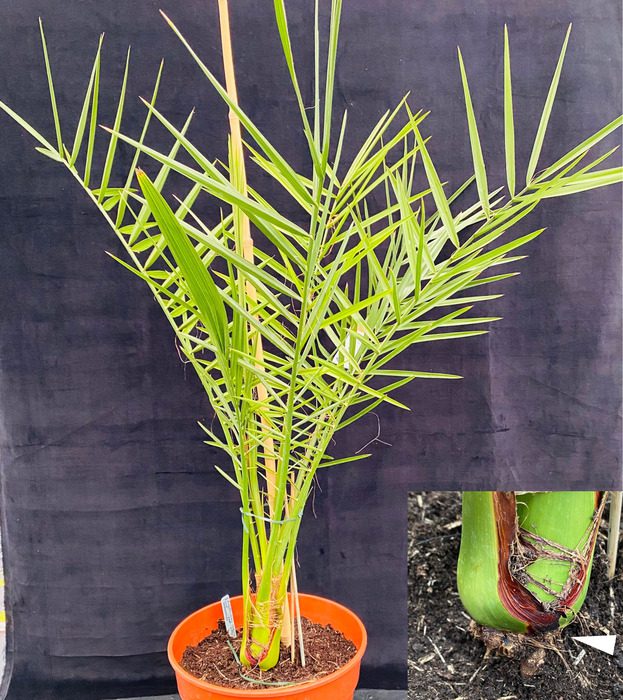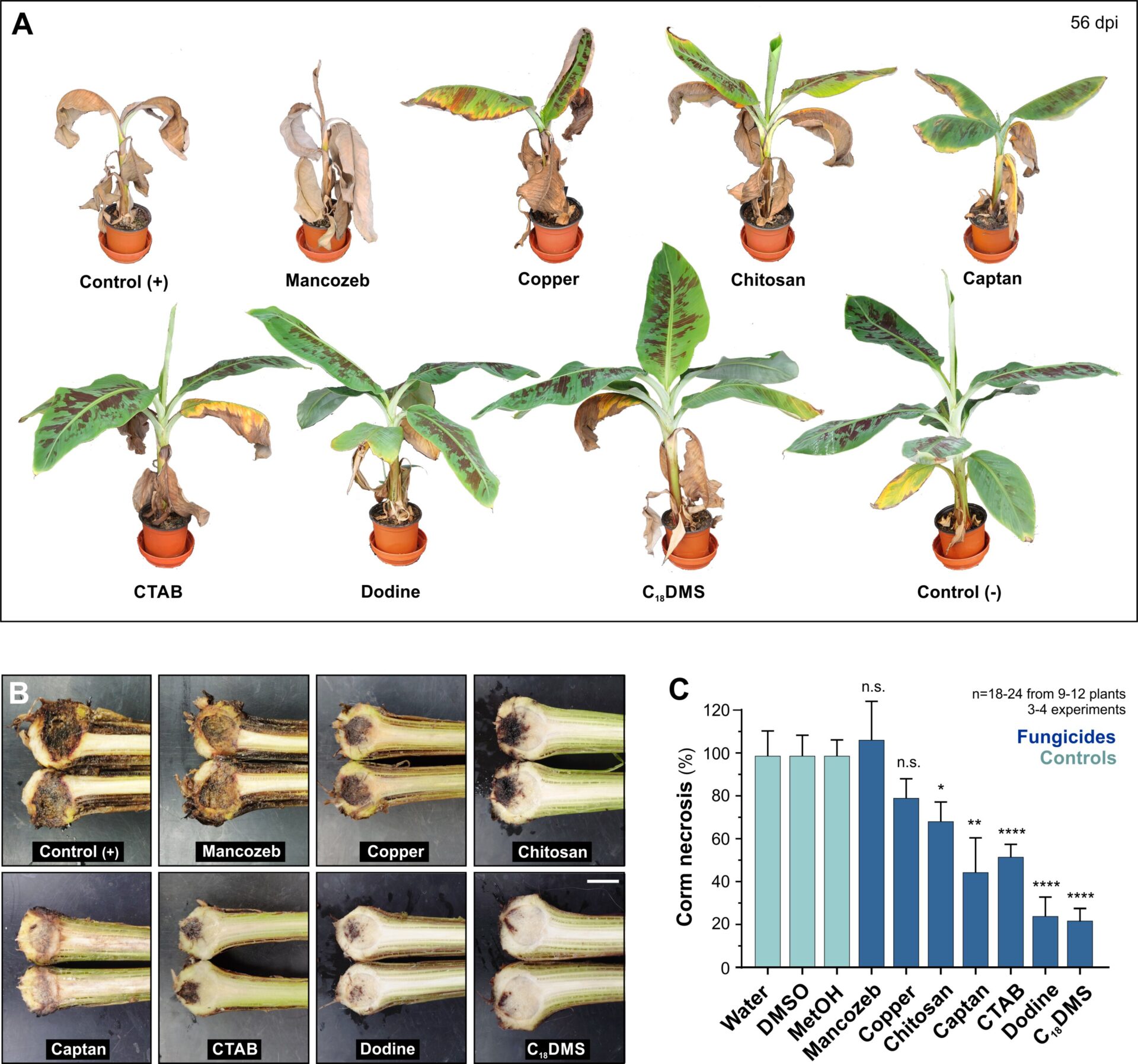
Date palm 2.5 years after grafting. Inset shows a magnified region at the base of the plant, with the arrowhead pointing to the graft junction.
CREDIT: Julian Hibberd
Scientists have found a novel way to combine two species of grass-like plant including banana, rice and wheat, using embryonic tissue from their seeds. The technique allows beneficial characteristics, such as disease resistance or stress tolerance, to be added to the plants.
Grafting is the technique of joining the shoot of one plant with the root of another, so they continue to grow together as one. Until now it was thought impossible to graft grass-like plants in the group known as monocotyledons because they lack a specific tissue type, called the vascular cambium, in their stem.
Researchers at the University of Cambridge have discovered that root and shoot tissues taken from the seeds of monocotyledonous grasses – representing their earliest embryonic stages – fuse efficiently. Their results are published today in the journal Nature.
An estimated 60,000 plants are monocotyledons; many are crops that are cultivated at enormous scale, for example rice, wheat and barley.
The finding has implications for the control of serious soil-borne pathogens including Panama Disease, or ‘Tropical Race 4’, which has been destroying banana plantations for over 30 years. A recent acceleration in the spread of this disease has prompted fears of global banana shortages.
“We’ve achieved something that everyone said was impossible. Grafting embryonic tissue holds real potential across a range of grass-like species. We found that even distantly related species, separated by deep evolutionary time, are graft compatible,” said Professor Julian Hibberd in the University of Cambridge’s Department of Plant Sciences, senior author of the report.
The technique allows monocotyledons of the same species, and of two different species, to be grafted effectively. Grafting genetically different root and shoot tissues can result in a plant with new traits – ranging from dwarf shoots, to pest and disease resistance.
The scientists found that the technique was effective in a range of monocotyledonous crop plants including pineapple, banana, onion, tequila agave and date palm. This was confirmed through various tests, including the injection of fluorescent dye into the plant roots – from where it was seen to move up the plant and across the graft junction.
“I read back over decades of research papers on grafting and everybody said that it couldn’t be done in monocots. I was stubborn enough to keep going – for years – until I proved them wrong,” said Dr Greg Reeves, a Gates Cambridge Scholar in the University of Cambridge Department of Plant Sciences, and first author of the paper.
He added: “It’s an urgent challenge to make important food crops resistant to the diseases that are destroying them. Our technique allows us to add disease resistance, or other beneficial properties like salt-tolerance, to grass-like plants without resorting to genetic modification or lengthy breeding programmes.”
The world’s banana industry is based on a single variety, called the Cavendish banana – a clone that can withstand long-distance transportation. With no genetic diversity between plants, the crop has little disease-resilience. And Cavendish bananas are sterile, so disease resistance can’t be bred into future generations of the plant. Research groups around the world are trying to find a way to stop Panama Disease before it becomes even more widespread.
Grafting has been used widely since antiquity in another plant group called the dicotyledons. Dicotyledonous orchard crops including apples and cherries, and high value annual crops including tomatoes and cucumbers, are routinely produced on grafted plants because the process confers beneficial properties – such as disease resistance or earlier flowering.
The researchers have filed a patent for their grafting technique through Cambridge Enterprise. They have also received funding from Ceres Agri-Tech, a knowledge exchange partnership between five leading UK universities and three renowned agricultural research institutes.
“Panama disease is a huge problem threatening bananas across the world. It’s fantastic that the University of Cambridge has the opportunity to play a role in saving such an important food crop,” said Dr Louise Sutherland, Director Ceres Agri-Tech.
Original Article: 3D-bioprinted tissues can now be stored in the freezer until needed
More from: University of Cambridge
The Latest Updates from Bing News & Google News
Go deeper with Bing News on:
Panama Disease
- 28 Interesting Facts About Panama
The most interesting facts about Panama include a canal that links oceans and one of the largest rainforests in the world.
- Panama, Suez Canal issues likely to impact costs for consumers, farmers
During the 1800s, there were many failed attempts to build a canal across points in Central America. To trade goods from the Atlantic to Pacific, seafarers had to take ...
- Colombian banana exports to increase in 2024
The Colombian industry sees two peaks for banana exports each year, the first happening now, between April-May.
- Strategies To Save The Global Banana Industry
The InnoBlac disease resistant cultivar growing in the ... Bananas that are resistant to both Panama Wilt and Black Sigatoka would be highly desirable for the growers. A non-browning trait would ...
- There are more than 1,000 varieties of banana, and we eat one of them. Here’s why that’s absurd
Panama disease, also known as fusarium wilt, is whipping through monocultures of Cavendish bananas in Asia, Australia, Africa and, most recently, in Latin America and the Caribbean, the source of ...
Go deeper with Google Headlines on:
Panama Disease
[google_news title=”” keyword=”Panama Disease” num_posts=”5″ blurb_length=”0″ show_thumb=”left”]
Go deeper with Bing News on:
Cavendish banana
- The health benefits of bananas
Like all foods we consume, there is always a possibility of allergy or food intolerance. The actual rate of banana reactions is estimated to be less than 1% and may be connected to a latex sensitivity ...
- Canarian Europlátano marks first shipment to Poland
Canary Islands organization Europlátano marked its first Poland-bound banana shipment on Jan. 10, as the group moves to secure “profitable and fair trade” markets for its growers.
- A North Carolina company is trying to make a fungus-proof banana
By the late 2010s, it was showing up in the soil of banana producing countries like Columbia and Costa Rica, which are home to the Cavendish banana — the variety you'll find at your local ...
- Fighting Banana Blight In A North Carolina Greenhouse
By the late 2010s, it was showing up in the soil of banana producing countries like Columbia and Costa Rica, which are home to the Cavendish banana — the variety you’ll find at your local grocery ...
- Strategies To Save The Global Banana Industry
Soon, there will either have to be a replacement or replacements for the Cavendish or the lyric – “yes, we have no bananas” will once again be relevant. Finding those solutions and proving ...
Go deeper with Google Headlines on:
Cavendish banana
[google_news title=”” keyword=”Cavendish banana” num_posts=”5″ blurb_length=”0″ show_thumb=”left”]










